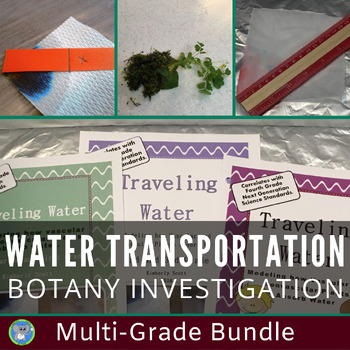Investigate How Plants Transport Water | Grade K To 5 Science Experiment Bundle
- Zip
- Easel Activity
Products in this Bundle (3)
Description
Discover how plants transport water in this fun and engaging investigation. Great for Differentiating. Students will learn that not all plants transport water in the same way. Color Chromatography makes it extra special.
By purchasing this bundle, you are SAVING 20% off each individual resource.
Digital and Distance Learning Approved. This is a great way to get students to use the scientific method at home. The supplies are common household items that can be modified. The files are PDF but come with a pre-created Easel by TpT overlay. We added text boxes and tips for completing it online. Click "Open in Easel" on each product page to get started. They can be added to your Google Classroom as an assignment. Students can also print and complete it. A science lab teacher can also assign all the grade levels, which allows families to conduct the experiment together. If you don't have Google Classroom, you can send the overlay as a link to Google accounts. If that is not possible, use the PDF in a program like Kami extension to create an online version with text boxes. We already did it for you in Easel. You could conduct the experiment as a demo for the students, and then they try it. Get creative!
Students will use different types of paper to model how plants transport water. The upper grades will expand into more detail about vascular and nonvascular plants. Students will follow the scientific method in an age-appropriate format. Students will create a conclusion using their evidence and reasoning. Students will answer the question:
Does the type of paper affect the distance water will travel?
Teachers will like its’ ease of use, simple materials, and background information. The 3-grade levels will allow the teacher to accommodate for different abilities. Great for the STEM/Science Lab Teacher. Students will enjoy performing a hands-on activity and understanding how plants transport water.
This hands-on Investigation and Teacher guide includes:
- Correlation to the *Next Generation Science Standards
- Investigation Lesson Plans
- Nonvascular and Vascular Plant Reading Material (Relates to the investigation and gives vocabulary.
- Simple and Unique Measurement directions for Kindergarten and 1st Grade
- Teacher Tips
- 3 Science Journals
- Assessment pages
- Answer Key
- Rubric
- Terms of Use
Supplies Needed
Paper Towels, Coffee Filters, Multipurpose Paper (copy paper), Wet Erase Markers or Water Based, Cups of Water, Eye Droppers, Foil, Ruler, Glue Sticks, Paper, Scissors, Nonvascular and Vascular Plant Samples (pictures can be used too.)
Great for classrooms, science fairs, homeschools, and clubs. Investigation can be done without relating to plants and just to learn about the paper.
Please see each product link for more details.
You might also like
Cloud In A Bottle Experiment Bundle: K-5 Grade Level Labs
Chemical Eruption Investigation: Vinegar And Baking Soda Lab Bundle For K-5th
Diffusion Lab Bundle: All 4 Science Journals. K-8th Grade
Remember leaving feedback earns you points toward FREE TPT purchases. I love hearing how the investigation went.
Also, follow me and be notified when new explorations are uploaded and deals.
Please contact me with any questions! I am here to help.
Yours in Science,
Kimberly Scott





